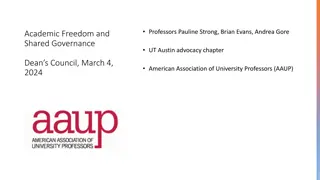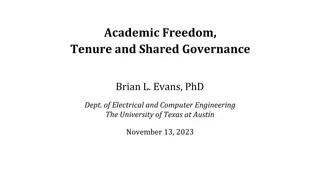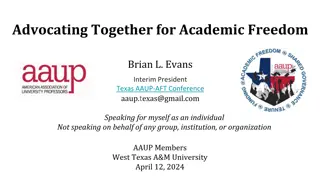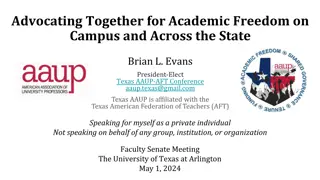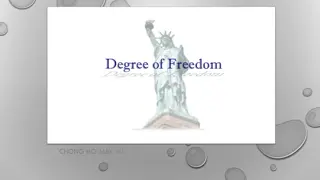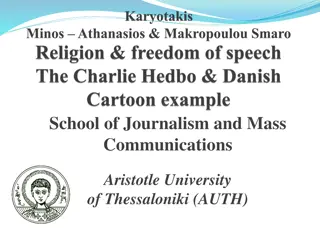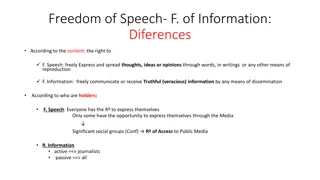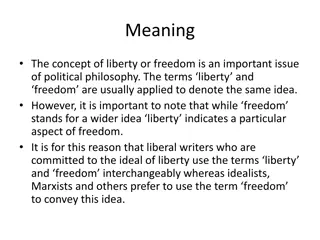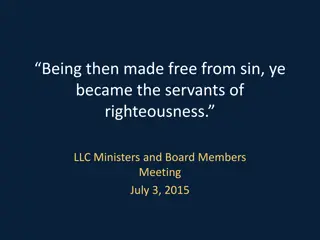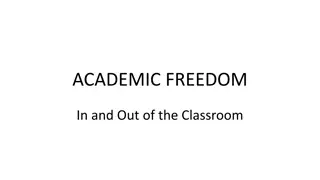Advocating Together for Academic Freedom - Importance and Principles
Advocating for academic freedom is crucial for the advancement of knowledge and quality education. The American Association of University Professors (AAUP) champions academic freedom, shared governance, and economic security for faculty members. The 1940 Joint AAUP/AAC&U Statement of Principles on Academic Freedom & Tenure outlines key elements such as freedom of exploration, discussion, and dissent, safeguarded by principles like tenure and shared governance.
Download Presentation

Please find below an Image/Link to download the presentation.
The content on the website is provided AS IS for your information and personal use only. It may not be sold, licensed, or shared on other websites without obtaining consent from the author. Download presentation by click this link. If you encounter any issues during the download, it is possible that the publisher has removed the file from their server.
E N D
Presentation Transcript
Advocating Together for Academic Freedom Brian L. Evans Interim President Texas AAUP Conference aaup.texas@gmail.com Speaking for myself as an individual Not speaking on behalf of any group, institution, or organization Palo Alto College, San Antonio, Texas February 23, 2024
American Association of University Professors AAUP founded in 1915 by faculty and has 45,000 members. AAUP champions academic freedom, advances shared governance, and organizes all faculty to promote economic security and quality education. AAUP affiliated with the American Federation of Teachers (1.7M members including 148,000 professors) Aug. 2022 Consider Joining AAUP
Alamo Colleges District D.3.5 (Policy) Academic Freedom and Responsibilities All members of the faculty are entitled to academic freedom as defined in the 1940 Statement of Principles on Academic Freedom and Tenure formulated by the Association of American Colleges and the American Association of University Professors as revised by these associations in November 1989 and January 1990 . https://www.alamo.edu/siteassets/district/about-us/leadership/board-of-trustees/policies-pdfs/section-d/d.3.5-policy.pdf
1940 Joint AAUP/AAC&U Statement of Principles on Academic Freedom & Tenure (2600 words) Amer. Assoc. Colleges & Universities (AAC&U): 860+ institutions Academic Freedom for teachers consists of interrelated elements freedom to explore all avenues of scholarship, research, and creative expression and to publish the results of such work freedom to discuss all relevant matters in the classroom freedom from institutional censorship or discipline when speaking or writing as participants in the governance of an educational institution freedom from institutional censorship when speaking or writing as a citizen Free inquiry, free expression, and open dissent are critical for student learning and the advancement of knowledge Safeguards include tenure, due process, shared governance 1940 Statement: https://www.aaup.org/report/1940-statement-principles-academic-freedom-and-tenure
1966 Statement on Government of Colleges and Universities (3500 words) Jointly formulated by Faculty (AAUP), Presidents (ACE) and Trustees (ACB) American Council on Ed. (ACE): 1500+ institutions Assoc. of Gov. Boards of Univ. & Colleges: 1300+ members including the Alamo Community College District Central Office Faculty have primary decision-making authority in Curriculum, subject matter, and methods of instruction Those aspects of student life which relate to educational process Matters related to faculty status appointments, reappointments, decisions not to reappoint, promotions, granting of tenure, and dismissal President should exercise adversely only in exceptional circumstances, and for reasons communicated to the faculty & receive faculty feedback Faculty have authority in financial exigency and program closures 1966 Joint Statement, https://www.aaup.org/report/statement-government-colleges-and-universities
1966 Joint AAUP/ACE/AGB Statement on Government of Colleges and Universities President shares responsibility in Definition and attainment of goals Administrative action Communications to link components of academic community President provides institutional leadership Innovate, initiate, and persuade others to work toward goals Utilize judgments of the faculty and outside competent scholars Ensure standards and procedures conform to policy established by the board and standards of sound academic practice Manage and create resources President represents institution to public 1966 Joint Statement, https://www.aaup.org/report/statement-government-colleges-and-universities
1966 Joint AAUP/ACE/AGB Statement on Government of Colleges and Universities Maintains a general overview of the institution Entrusts conduct of administration to administrative officers Entrusts conduct of teaching and research to the faculty Publishes codified statements defining policies and procedures Provides long-term resource planning and oversees endowment Obtains capital and operating funds Supports institution when ignorance or ill will threatens any part In grave crises it will be expected to serve as a champion. Governing Board Roles 1966 Joint Statement, https://www.aaup.org/report/statement-government-colleges-and-universities
Legislative and Community Advocacy Higher ed is a mystery to Legislators and the general public 48% of Texans aged 25-64 have enrolled in an institution of higher ed 30% of Texans aged 25-64 have completed higher ed certificate or degree Advocacy is telling your story about how higher ed helps our state Why are academic freedom, tenure, shared governance, and other higher ed values are important to you in teaching, research and expression? How has the teaching and research in your discipline benefitted Texans? As a private citizen, you have freedom to express your views per First Amendment Rights be clear who you are speaking for And you can team up with a group to advocate .
Texas AAUP Conference Members at 75 universities, comm. colleges, health-related inst. AAUP affiliated with Amer. Federation of Teachers Aug. 1, 2022 Advocacy for higher ed values Ramped up by Texas AFT (10/22) and NAACP LDF (2/23) Wrote op-eds and blogs, and tweeted @TexasAaup Interviewed with reporters ** Created a higher ed bill tracker Coordinated with 10 higher ed advocacy orgs Legislative training, updates and visits ** Testifying at Texas Senate and House committee hearings ** Campaigns for Legislative outreach ** ** As private citizens / AAUP members
Building Legislative Coalitions NAACP LDF and Texas AFT connected our 10 orgs with Legislative Black Caucus Mexican American Legislative Caucus Other Legislators Picture by the Texas Tribune End Goals Amending a bill needs approval from the bill s sponsor Bill s opponents can use procedural tactics on floor to stop a bill Rep. Chris Turner stopped SB 1987 on loosening accreditation standards
Visiting Legislative Offices Texas AAUP and Texas AFT trained 30 faculty to visit Legislative offices in teams of 2-4 We built bipartisan relationships with more than 50 of 181 Legislative Offices Legislative staff appreciate visits because it helps them sort through the 8000+ bills Typical office has student interns and many full-time staff are recent grads and some are part-time graduate students good icebreaker to ask where they went to college Picture from left to right is Brian Evans (Texas AAUP) David Albert (Texas AFT & Texas AAUP) Rep. Vicki Goodwin on firstday of Texas Legislative Session
Testifying at Committee Hearings Texas AAUP and Texas AFT trained hundreds of faculty to present oral and written testimony at committee hearings on censorship, anti-DEI & anti- tenure bills In-person testimony at House Higher Ed Committee hearings in May 70 against anti-tenure bill 130 against anti-DEI bill Hundreds submitted written testimony April 6, 2023, after testifying against the anti-DEI SB 17 at the Senate Higher Education Subcommittee hearing at the Texas Capitol. Allen Liu (farthest left) and Hamida Labi (front row; third from left) NAACP Legal Defense Fund; Polly Strong (back row; farthest left) Texas AAUP; Irene Mulvey (back row; second from left) National AAUP President; Brian Evans (back row; third from right) Texas AAUP VP; Miriam Leaky (back row; second from right) Legislative Black Caucus; Emilio Zamora (front row; second from left) and Angela Valenzuela (front row; second from right) Director of Black Brown Dialogues on Policy and Member of AAUP
Advocacy Outcomes In the House, our coordinated effort among 10 higher ed advocacy orgs Able to change the legal definition of tenure in tenure bill from one- year guaranteed contracts to continuous employment. Influenced changes in anti-DEI bill including several exceptions for external grants. Helped defeat the censorship bill Karma R. Ch vez, Lessons from AAUP Advocacy in Texas, Academe, 2023. How a revived AAUP chapter and a coalition of allies mobilized against a legislative assault.
Thank You! Consider joining AAUP Consider forming an AAUP Chapter on campus Helps faculty connect with other faculty across campus Gives training on academic freedom, departmental and college governance, and how to get your voices heard Works with Faculty Senate to change policies and encourages members to run for Faculty Senate Provides faculty mentoring Hosts seminars on academic freedom Gives training in Legislative advocacy Advocates at the State Legislature




